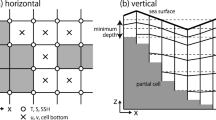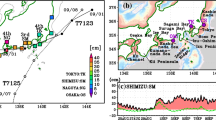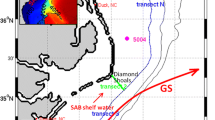Abstract
We have developed a coastal model of the Seto Inland Sea, Japan, for a monitoring and forecasting system operated by the Japan Meteorological Agency (JMA). We executed a hindcast experiment using reanalysis datasets for the atmospheric and lateral boundaries without ocean initialization by data assimilation. The seasonal variability is verified to be realistic by comparing sea surface temperature and salinity of the hindcast experiment with observations. With a horizontal resolution of approximately 2 km, the model represents explicitly various coastal phenomena with a scale of 10–100 km, such as the Kuroshio water intrusion into Japanese coasts. This leads to good representation of intramonthly variations. For example, intensity of the sea level undulations with a period shorter than 23 days shows 1.6-fold improvement, as compared to the present model of JMA with the horizontal resolution of approximately 10 km. In addition to the increased resolution, the model is optimized for coastal modeling as follows. Incorporation of a tidal mixing parameterization reduces a high temperature bias in the Bungo Channel (a western channel of the Seto Inland Sea) and contributes to formation of a frontal structure. An accurate dataset of the river discharges is used for runoff, which has a strong impact on salinity. Enhancement of coastal friction improves surface currents. Owing to the increased resolution and these optimizations, the model shows realistic variability in a wide temporal range from several days to seasons. Root-mean-square errors of sea surface temperature and heights are evaluated as 1–2 K and 7–10 cm, respectively, without data assimilation. In the eastern part, however, the predictability is relatively low, which might be related to representation of an eastward mean flow in the Seto Inland Sea.



















Similar content being viewed by others
Notes
Strictly, we used a development version of MRI.COM (ver.3.3) for the experiments in the paper, while JMA’s operation uses a stable version (ver.3.2). Nevertheless, the model performance is the same, since the configurations are identical.
References
Adcroft A, Campin JM (2004) Rescaled height coordinates for accurate representation of free-surface flows in ocean circulation models. Ocean Modell 7:269–284. doi:10.1016/j.ocemod.2003.09.003
Arakawa A (1972) Design of the ucla general circulation model. numerical simulation of weather and climate. Tech Rep. 7. Dept of Meteorology, University of California, Los Angeles
Chang P H, Guo X, Takeoka H (2009) A numerical study on the seasonal circulation in the Seto Inland Sea, Japan. J Oceanogr 65(6):721–736
Fujiwara T (1983) Water mass exchange between the Seto Inland Sea and the open ocean. Umi to Sora 59 (1):7–17. (in Japanese)
Futamura A, Takeoka H, Guo X (2005) Current, water exchange and heat budget in the stratified region of Hiuchi-Nada. Oceanography in Japan 14(3):429–440
Griffies SM, Hallberg RW (2000) Biharmonic friction with a Smagorinsky-like viscosity for use in large-scale eddy-permitting ocean models. Mon Wea Rev 128:2935–2946. doi:10.1175/1520-0493(2000)128<2935:BFWASL>2.0.CO;2
Hanawa K, Mitsudera H (1985) On the data processings of daily mean values of oceanographical data: Note on the daily mean sea-level data. Bulletin on Coastal Oceanography 23(1):79–87. (in Japanese)
Imasato N, Qiu B (1987) An event in water exchange between continental shelf and the Kuroshio off southern Japan: Lagrangian tracking of a low-salinity water mass on the Kuroshio. J Phys Oceanogr 17:953–968. doi:10.1175/1520-0485(1987)017<0953:AEIWEB>2.0.CO;2
Ishizaki H, Yamanaka G (2010) Impact of explicit sun altitude in solar radiation on an ocean model simulation. Ocean Modell 33:52–69. doi:10.1016/j.ocemod.2009.12.002
Ishizaki S, Soga T, Usui N, Fujii Y, Tsujino H, Ishikawa I, Yoshioka N, Kuragano R, Kamachi M (2009) Overview and operational system development of MOVE/MRI.COM. Weather Service Bulletin 76:S1—S15. (in Japanese)
Isobe A, Guo X, Takeoka H (2010) Hindcast and predictability of sporadic Kuroshio-water intrusion (Kyucho in the Bungo Channel) into the shelf and coastal waters. J Geophys Res 115:C04,023. doi:10.1029/2009JC005818
Isobe A, Kako S, Guo X, Takeoka H (2012) Ensemble numerical forecasts of the sporadic Kuroshio water intrusion (kyucho) into shelf and coastal waters. Ocean Dyn 62(4):633–644
Kunii M, Fujiwara T (2006) Through flow of the Seto Inland Sea driven by the sea level difference between western and eastern boundaries. Umi to Sora 81(2):63–72. (in Japanese)
Kuroda H, Setou T, Aoki K, Takahashi D, Shimizu M, Watanabe T (2013) A numerical study of the Kuroshio-induced circulation in Tosa Bay, off the southern coast of Japan. Continental Shelf Res 53:50–62. doi:10.1016/j.csr.2012.12.005
Kuroda H, Hirota Y, Setou T, Aoki K, Takahashi D, Watanabe T (2014) Properties of winter mixed layer variability on the shelf-slope region facing the Kuroshio - study of Tosa Bay, southern Japan. Ocean Dyn 64(1):47–60. doi:10.1007/s10236-013-0670-9
Large WG, Yeager SG (2004) Diurnal to decadal global forcing for coean and sea-ice models: the data sets and flux climatologies. NCAR Tech. Note: TN-460+STR, CGD Division of the Natinal Center for Atmospheric Research
Lee HC, Rosati A, Spelman MJ (2006) Barotropic tidal mixing effects in a coupled climate model: Oceanic conditions in the Northern Atlantic. Ocean Modell 11(3):464–477. doi:10.1016/j.ocemod.2005.03.003
Miyazawa Y, Miyama T, Varlamov S M, Guo X, Waseda T (2012) Open and coastal seas interactions south of Japan represented by an ensemble Kalman filter. Ocean Dyn 62(4):645–659
Nagai T, Hibiya T (2012) Numerical simulation of tidally induced eddies in the Bungo Channel: a possible role for sporadic Kuroshio-wate intrusion (kyucho). J Oceanogr 68:797–806. doi:10.1007/s10872-012-0141-9
Nakada S, Ishikawa Y, Awaji T, In T, Shima S, Nakayama T, Isada T, Saitoh SI (2012) Modeling runoff into a region of freshwater influence for improved ocean prediction: Application to Funka Bay. Hydrological Research Letters 6:47–52. doi:10.3178/HRL.6.47
Nishiyama K (ed.) (2013) Climate and marine conditions of the Seto Inland Sea. The Marine Meteorological Society. (in Japanese)
Noh Y, Kim H J (1999) Simulations of temperature and turbulence structure of the oceanic boundary layer with the improved near-surface process. J Geophys Res 104:15
Prather MJ (1986) Numerical advection by conservation of second-order moments. J Geophys Res 91 (D6):6671–6681. doi:10.1029/JD091iD06p06671
Sakamoto K, Tsujino H, Nishikawa S, Nakano H, Motoi T (2010) Dynamics of the Coastal Oyashio and its seasonal variation in a high-resolution western North Pacific Ocean model. J Phys Oceanogr 40(6):1283–1301. doi:10.1175/2010JPO4307.1
Sakamoto K, Tsujino H, Nakano H, Hirabara M, Yamanaka G (2013a) A practical scheme to introduce explicit tidal forcing into an OGCM. Ocean Sci 9:1089–1108. doi:10.5194/os-9-1089-2013
Sakamoto K, Yamanaka G, Tsujino H, Nakano H, Hirabara M (2013b) Development of a 2km-resolution Japanese coastal ocean model: Toward a next-generation operational monitoring and forecasting system. Weather Service Bulletin 80:S99—S109. (in Japanese)
Sakamoto K, Yamanaka G, Tsujino H, Nakano H, Hirabara M (2014) Development of a 2km-resolution Seto Inland Sea model, MRI.COM-Seto, and a Japanese coastal ocean model, MRI.COM-JPN. Weather Service Bulletin 81:S63—S75. (in Japanese)
Sun YJ, Isobe A (2008) Lagrangian H/U3 values computed around fronts using a fine-resolution numerical model and ferryboat-monitored SST dataset. J Phys Oceanogr 38(11):2575–2586. doi:10.1175/2008JPO3839.1
Toda T (1992) Double structure of the coastal front in the Kii Channel, Japan, during winter. J Geophys Res 97(C7):11, 333–11, 342. doi:10.1029/92JC00589
Toda T (1993) Movement of the surface front by Kuroshio frontal eddy. J Geophys Res 98(C9):16,331–16,339,. doi:10.1029/93JC01027
Tsujino H, Motoi T, Ishikawa I, Hirabara M, Nakano H, Yamanaka G, Yasuda T, Ishizaki H (2010) Reference manual for the Meteorological Research Institute Community Ocean Model (MRI.COM) version 3. Tech Rep. 59. Meteorological Research Institute, Japan
Tsujino H, Hirabara M, Nakano H, Yasuda T, Motoi T, Yamanaka G (2011) Simulating present climate of the global ocean-ice system using the Meteorological Research Institute Community Ocean Model (MRI.COM): simulation characteristics and variability in the Pacific sector. J Oceanogr 67:449–479. doi:10.1007/s10872-011-0050-3
Tsujino H, Sakamoto K, Usui N (2015) Development of coastal ocean models at the Meteorological Research Institute of the Japan Meteorological Agency. Bulletin of Coastal Oceanography 5(2):119–129. (in Japanese)
Tsutsumi E, Guo X, Yoshie N, Matsuno T, Mano T, Nakagawa M (2014) Vertical mixing in Iyo-Nada: Comparison between a stratification period and a non-stratification period.. In: Proceedings of the Oceanographic Society of Japan fall meeting, p 64. (in Japanese)
Uchiyama Y, Kuriyama T, Miyazawa Y (2012) Impact of the Kuroshio paths on oceanic and estuarine circulations in and around Seto Inland Sea. Journal of Japan Society of Civil Engineers, Ser B2 (Coastal Engineering) 68 (2):I441–I445. doi:10.2208/kaigan.68.I_441
Urakawa L S, Kurogi M, Yoshimura K, Hasumi H (2015) Modeling low salinity waters along the coast around japan using a high resolution river discharge data set. J Oceanogr pp –. (submitted)
Usui N, Sakamoto K, Ogawa K, Fujii Y, Tsujino H, Yamanaka G, Kuragano T, Kamachi M (2014) Hindcast experiment of an abnormal tidal height event in the Seto Inland Sea by a monitoring and forecasting system of Japanese coastal seas. Weather Service Bulletin 81:S53—S62. (in Japanese)
Usui N, Fujii Y (2015) Sakamoto K. Development of a four-dimensional variational assimilation system toward coastal data assimilation around Japan. Monthly Weather Review pp –, Kamachi M. (submitted)
Yanagi T, Koike T (1987) Seasonal variation in thermohaline and tidal fronts, Seto Inland Sea, Japan. Continental Shelf Res 7(2):149–160. doi:10.1016/0278-4343(87)90076-8
Yanagi T, Ohba T (1985) A tidal front in the Bungo Channel. Bulletin on Coastal Oceanography 23 (1):19–25. (in Japanese)
Acknowledgments
We thank the members of the oceanography and geochemistry research department of Meteorological Research Institute for fruitful discussions and helpful comments. This work was funded by MRI and was partly supported by JSPS KAKENHI Grant Number 24740323.
Author information
Authors and Affiliations
Corresponding author
Additional information
Responsible Editor: Emil Vassilev Stanev
This article is part of the Topical Collection on Coastal Ocean Forecasting Science supported by the GODAE OceanView Coastal Oceans and Shelf Seas Task Team (COSS-TT)
Appendix A: Improvement of the bottom topography
Appendix A: Improvement of the bottom topography
Our MRI.COM model imposes a minimum depth of 32 m due to a restriction of the sigma-z vertical coordinate (Fig. 1b). However, in the latest version of the MRI.COM (ver.4.0), shallower topography can be made by using the z∗ vertical coordinate (Adcroft and Campin 2004). Here, we investigate how this update affects the model performance in coastal regions, by executing an additional experiment, case SHALLOW. In SHALLOW, the z∗ coordinate is used to decrease the minimum depth from 32 to 9 m, and the bottom topography is improved to represent shallow regions in the Seto Inland Sea (Fig. 20b). The experimental settings are the same as CTL, except for the topography.
In the result, SST shows clearly an impact of the topography improvement. Figure 20 shows SST in July, when temperature difference between CTL and SHALLOW is largest throughout the year. In CTL, SST is approximately 23∘C almost homogeneously in the Seto Inland Sea. In SHALLOW, SST is higher than 25∘ C in the regions shallower than 20 m (the black line in Fig. 20b) and shows inhomogeneous distribution reflecting the bottom topography. The satellite observation shows similar distribution that SST is relatively high in the shallow regions, indicating that SST in SHALLOW is more realistic than in CTL. In winter, SST in the shallow regions of SHALLOW is colder than in CTL, and SST becomes inhomogeneous as in summer. This is also similar to the satellite observation (not shown). These differences in the shallow regions are attributed to a decrease in the heat capacity, which results in faster and more sensitive response to atmospheric forcings. However, it should be noted that the RMSE against the coastal observation increases at some stations, though it decreases at other stations. As a result, the RMSE averaged over the 19 stations in the Seto Inland Sea decreases only slightly from 1.8 K in CTL to 1.7 K in SHALLOW.
As for SSH, though time variation is simulated differently from CTL, the RMSE against the coastal observation does not show systematic difference. The RMSE averaged over the 43 stations in the Seto Inland Sea is 7.9 cm in CTL and 7.8 cm in SHALLOW. The case SHALLOW does not produce an observable change for the annual mean current (Fig. 17) or progression of the water exchange (Fig. 19), either. On the other hand, the transport rate of the eastward mean flow through the Seto Inland Sea decreases significantly from 18.8×103 m3 s−1 to 7.7×103 m3 s−1, and the direction of the throughflow is inverted a few times a month. This seems more consistent with Kunii and Fujiwara (2006) than in CTL.
We conclude that good effects of the topography improvement are confirmed for SST and the transport rate of the throughflow. However, further tunings are needed to make a contribution to decrease in errors against coastal observations. On the basis of this result, we are developing a next version of the operational coastal model, using the z∗ coordinate.
Rights and permissions
About this article
Cite this article
Sakamoto, K., Yamanaka, G., Tsujino, H. et al. Development of an operational coastal model of the Seto Inland Sea, Japan. Ocean Dynamics 66, 77–97 (2016). https://doi.org/10.1007/s10236-015-0908-9
Received:
Accepted:
Published:
Issue Date:
DOI: https://doi.org/10.1007/s10236-015-0908-9





